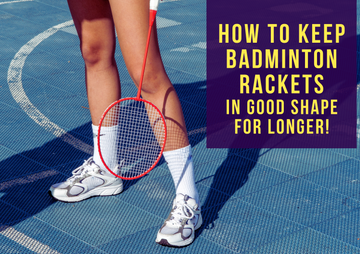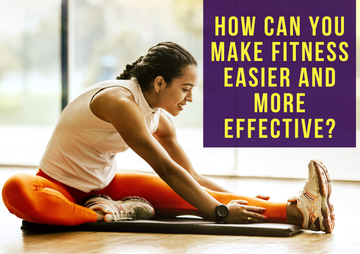How to Keep Badminton Rackets in Good Shape for Longer
No matter how expensive your racket is, you’ll need to learn how to maintain it so that it lasts longer – this saves can save you money in equipment.
It is important for beginners to learn the basics of racket care so that they can improve their game and enjoy the sport even more.
6 Common Badminton Problems and How to Fix Them
Badminton is highly addictive and you’ll constantly want to play every chance you get. The rackets and shuttlecock (although cheaper than their tennis counterparts) can put a huge chunk in your athletic budget if you needlessly ruin them because of improper use.
Here are common badminton racket issues that you can prevent or address quickly so that you can enjoy your equipment for a relatively longer period:
1. High String Tension
This refers to tight strings that are incorrectly strung on rackets. String tension ranges should be:
- for beginners, 16 – 19 lbs (racket weight)
- for intermediates 18 – 23 lbs (racket weight)
- for more advanced players 23 – 28 lbs (racket weight)
Professionals string their rackets at the rate of 26 to 32 lbs.
Tightly strung rackets can cause a badminton frame to crack or break. The wrong string tension is the no. 1 reason for shoulder soreness and other injuries. Tight strings require you to exert more effort for each shot.
2. Poor Handling
Letting go of rackets unexpectedly in mid-air cracks more badminton rackets than you can imagine. Experts advise applying protection tape on frames to prevent racket damage. The tape also protects rackets from nicks and scratches.
3. When Strings Snap
Try to immediately fix any strings that snap, even if its just one thread. Cut the affected thread promptly so that string tension remains stable.
4. Frame Corrosion and Chipped Paint
Corrosion is an unavoidable event that can happen to the best of badminton rackets, especially steel rackets. Give your racket’s frame a fresh coat of paint whenever you notice it chipping to
keep rust away. It’s always important to store rackets properly so that they avoid extreme moisture, which is another factor that contributes to corrosion.
5. Missing or Damaged Grommets
Grommets are a critical part of your rackets because they keep strings from slicing through the frame. These tiny plastic tubes are designed to hold strings and maintain the correct tension. Replace missing grommets as soon as you notice any missing.
6. Loose Strings
In badminton where string tension is everything, loose strings make it impossible for you to play at all. You’ll need to restring your rackets every few months to keep your racket in top condition.
Proper Badminton Racket Maintenance
Enjoying badminton as a hobby or a serious sport will mean that you’ll also need to care about your equipment so that you’ll get more games out of them.
Store your rackets in thermal bags and invest in quality frames and strings, along with protection tape to protect your rackets.
Taking the time to care for your rackets not only ensures they’ll last longer, but it also enhances your gameplay, making every match more enjoyable and safer. By keeping your equipment in top condition, you’ll always be ready for your next thrilling game!
Improving your grip on a Badminton Racket can significantly impact your performance. Here are some top BONUS tips to help you get the best grip!
- Choose the Right Grip Size:
The correct grip size is essential for control and comfort. If your grip is too small, you’ll have to squeeze the handle too hard, leading to fatigue. If it’s too large, you may struggle with maneuverability. Test different sizes and find one that fits your hand comfortably.
- Understand the Different Grip Types:
Forehand Grip: Ideal for most forehand shots. Hold the racket as if you're shaking hands with it, ensuring that there’s a V-shape formed between your thumb and index finger.
Backhand Grip: Rotate the racket slightly in your hand so your thumb presses against the back of the handle. This provides more control and power for backhand shots.
Neutral Grip: For switching quickly between forehand and backhand. Keep your grip relaxed, allowing for quick adjustments as needed.
- Use the Right Grip Material:
Towel Grips: Absorb sweat well, providing a non-slip surface, but they can become heavy when wet and require frequent replacement.
PU Grips: Popular for their comfort and tackiness. They offer a good balance of sweat absorption and durability.
Overgrips: A thin layer that can be wrapped over the existing grip for extra thickness, improved grip texture, or added cushioning.
- Maintain the Right Grip Pressure:
Avoid gripping the racket too tightly. A firm but relaxed grip allows for better racket control and quicker wrist movements. Grip pressure should be tighter on impact and relaxed during preparation and follow-through.
- Replace Grips Regularly:
Over time, grips can wear out, become slippery, or lose their cushioning. Regularly replacing your grip helps maintain control and comfort. Signs that it's time to replace a grip include loss of tackiness, wear and tear, or discomfort during play.
- Keep Your Hands Dry:
Sweat can make the grip slippery. Use a wristband to keep sweat from dripping down, or keep a towel handy to dry your hands between points. Some players use grip powder or rosin for added dryness.
- Customize Your Grip:
Some players prefer to add extra layers of overgrip or wrap certain areas thicker for a custom feel. Experiment with different wrapping techniques to find what works best for your playing style.
- Mind the Position of Your Fingers:
Make sure that your fingers are positioned correctly on the handle. The thumb should be placed on the wider, flat side of the handle for backhand shots, and your index finger should guide the racket for forehand shots. Proper finger positioning provides better control and precision.
By following these tips, you can ensure a more comfortable and effective grip, leading to improved performance on the court!
For those who love sports!
Trained Outdoor Basketballs, Performance Rubber Cover
Trained 10 Man Flag Football Belts
Yonex Badminton Rackets
Check out our previous articles!
At What Age Can Kids Play Badminton?
How a 10 Minute Walk Can Improve Your Overall Well Being
6 Light Stretches to Help You Sleep Better
5 Simple Stretches to Relieve Lower Back Pain
What Are The Health Benefits of Swimming?
8 Simple Tips to Declutter Your Space and Your Mind
















